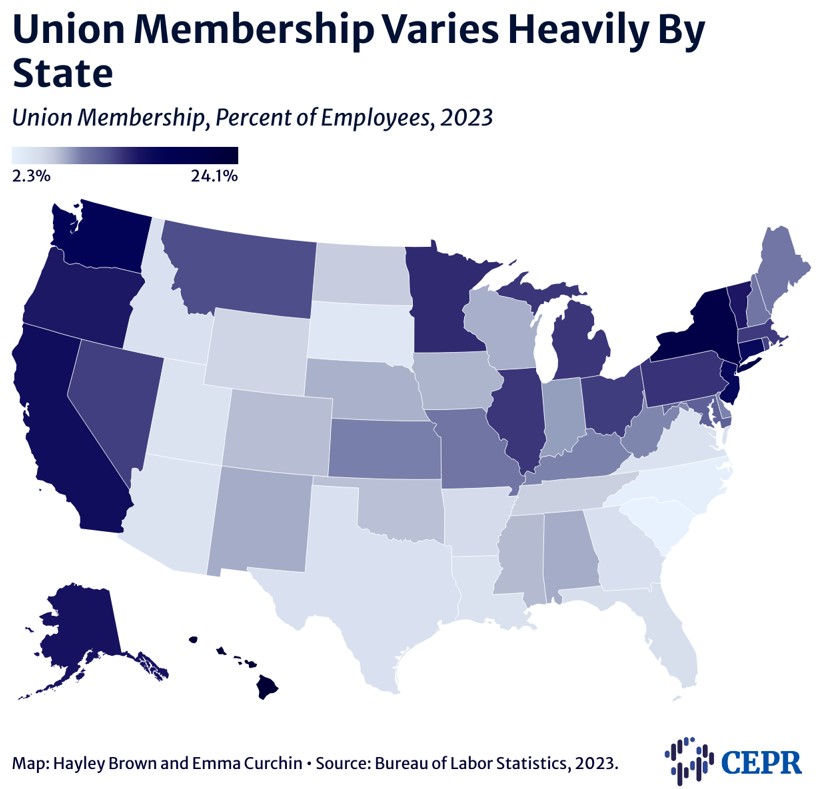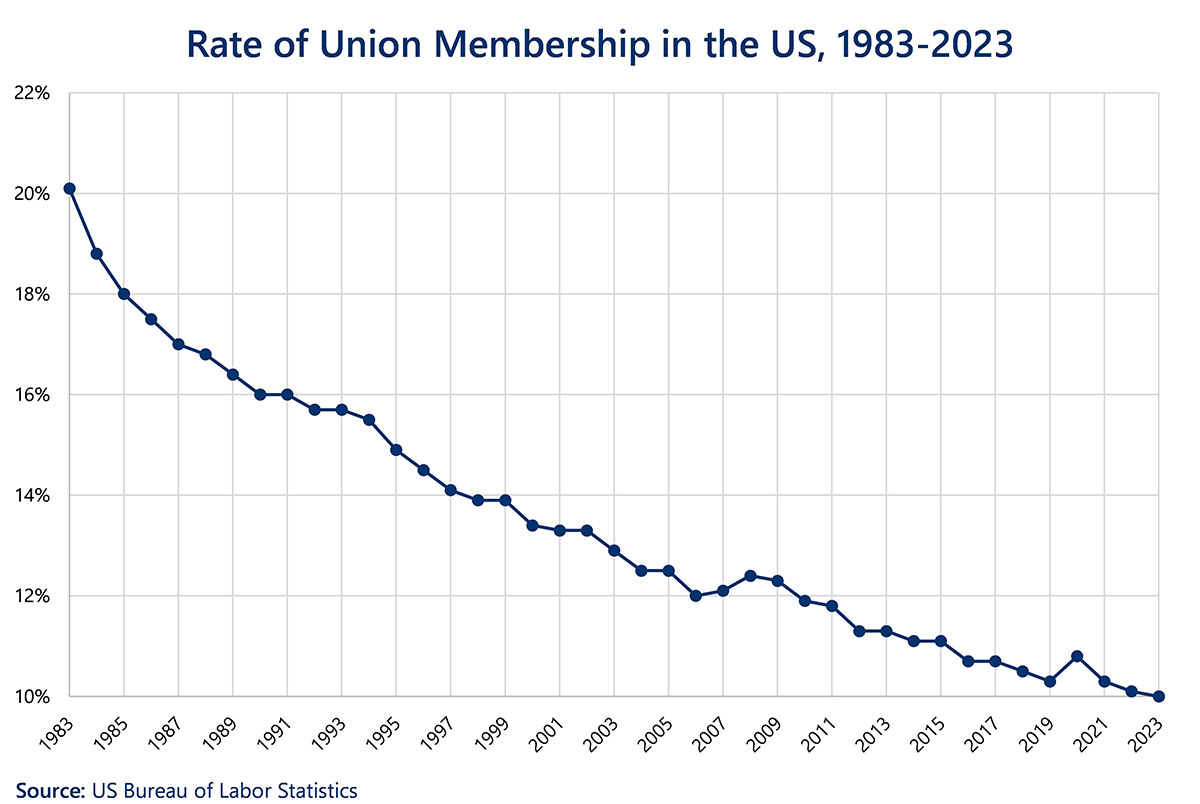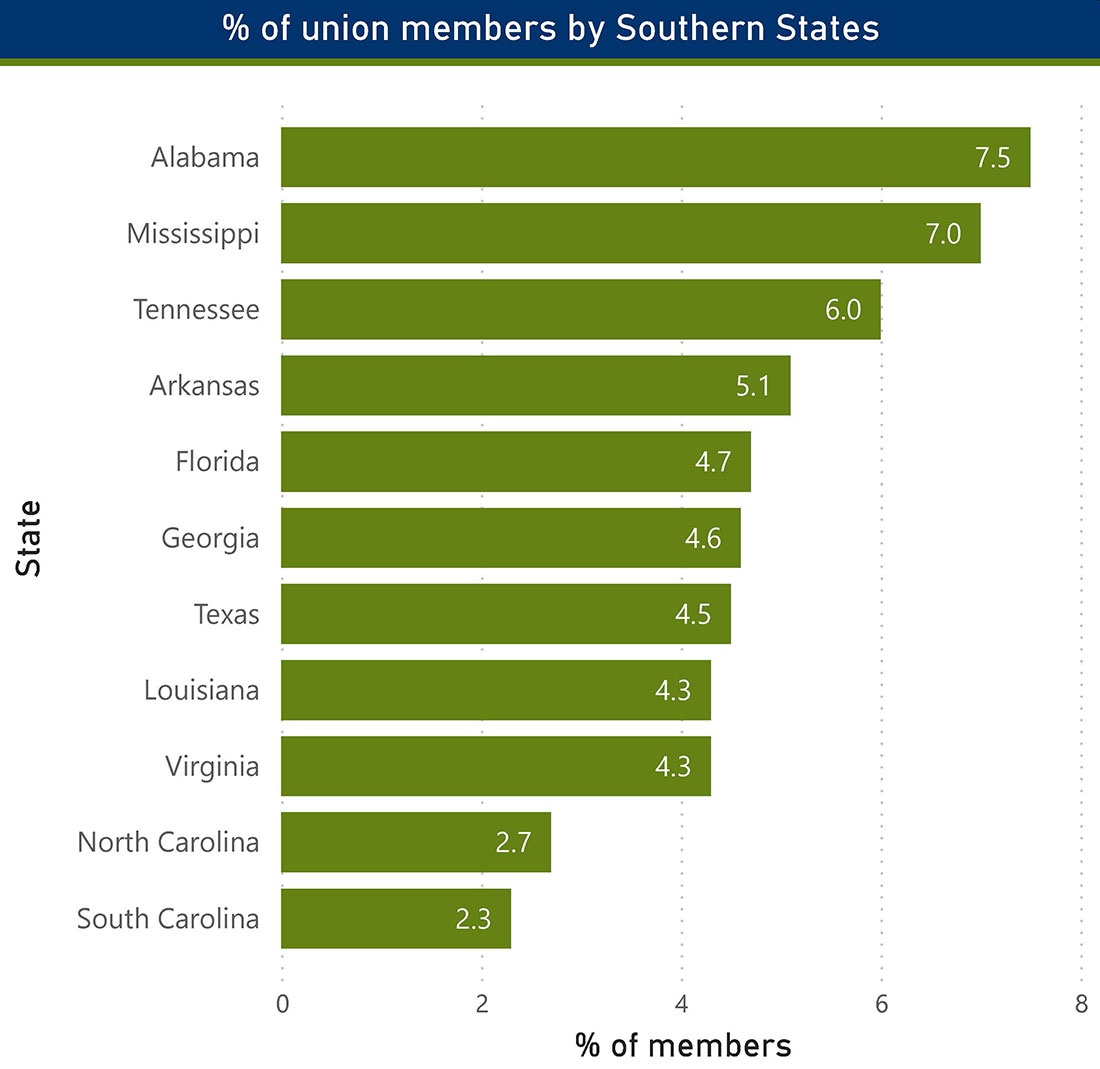- Navigator
- Southeast
- Business Retention and Expansion (BRE)
- Prospecting and Business Attraction
- Workforce Development
- Regional
 Camoin Associates understands this is a very nuanced and complex topic and remains impartial in its viewpoints on whether unionization is the right fit for communities.
Camoin Associates understands this is a very nuanced and complex topic and remains impartial in its viewpoints on whether unionization is the right fit for communities.
Over the past few months, the industrial labor scene in the Southern United States has seen a big change: Workers in this traditionally non-union region are starting to unionize.
Earlier this year, workers at a Volkswagen plant in Tennessee and a Mercedes-Benz plant in Alabama voted on whether or not to join the United Auto Workers (UAW) union. The workers in Tennessee overwhelmingly approved the proposal, while the workers in Alabama voted against it. Despite the mixed results, the UAW has vowed to pour millions into continued efforts to grow its influence and unionize more workplaces in the South, targeting the automotive sector and others.
Additionally, in 2022, low-wage workers in many sectors across multiple southern states formed the Union of Southern Service Workers, which, among other things, is supporting Waffle House workers in Georgia and the Carolinas who have been striking over low pay and unsafe working conditions.
It’s an interesting trend because Southern states have historically been less unionized than other parts of the country, even in recent years. These organizing efforts challenge the status quo and could set a new precedent for how workforces in similar industries across the South approach the issue of unions going forward. For economic developers in the South, the name of the game now is learning how to navigate this new labor landscape.
 Image Source: “States of the Unions: The ‘Where’ of the US Labor Movement,” Center for Economic and Policy Research, May 1, 2024
Image Source: “States of the Unions: The ‘Where’ of the US Labor Movement,” Center for Economic and Policy Research, May 1, 2024
Historical Context
Unions have existed in the United States since before the country was formed, with the first recorded labor strike occurring in 1768.
Since then, the US labor movement has played a significant role in protecting workers’ rights and giving them a way to collectively bargain for better pay and other benefits. Most notably, the US labor movement worked to abolish child labor, establish a 40-hour work week, improve worker safety, and provide assistance to workers who were injured on the job. A report released last year by the US Department of the Treasury concluded that unions also support a healthy middle class and help reduce income inequality.
Since the early 1900s, unions have been a major force in the automotive and manufacturing industries, especially in places like Detroit, where the big car manufacturers were the community’s main employers. The UAW union was founded in the 1930s, and over the decades, it has fought tough battles with the major automotive companies for safer working conditions, higher wages, and better benefits.
The influence of unions in the US has ebbed and flowed over the years depending on economic conditions, company tactics, and the political climate. However, down South, there has been deep-rooted resistance to unions for a very long time.
Some of that resistance reflects the cultural values in the region that emphasize individualism. However, the main reason is that almost all Southern states have “Right to Work” laws in place that make it optional for workers to join or support a union, resulting in much lower unionization rates than other parts of the country.
Although public support for unions has been increasing in the US, the share of workers represented by a union has also been steadily declining, dropping from around 20% of workers in 1983 to just 10.1 % in 2023. This is because we have been adding non-union jobs to our economy at a much faster rate than union jobs, but also hints at some potential issues with how unions are perceived and how effective they are in today’s workplaces.
Image Source: Camoin Associates using US Bureau of Labor Statistics data
Part of the drop in union membership can be attributed to the economic shift from unionized manufacturing to more service-oriented industries. However, increasing globalization, changes to labor laws, and an overall perception that unions may not be as relevant anymore have also played a role. The trend also reflects a broader societal move toward more flexible, individualized work arrangements that unions have traditionally struggled to adapt to.
That said, we are seeing renewed worker interest and unionization efforts in multiple sectors, including services, technology, and healthcare, which are often being driven by younger workers. Also, despite these drops in union membership, there has been a reverse trend in Americans’ approval rates of Labor Unions, which had increased to the highest point since 1965 when it reached 71% in 2022.
The Potential Benefits of Increased Unionization
The unionization of a large automotive plant like Volkswagen may draw the attention of businesses that actually prefer — or at least don’t mind — having a unionized workforce environment. Unions can help build a more skilled, stable workforce with higher satisfaction and less turnover, and these companies may value the organized wage scales, availability of skilled labor, and training systems often found at unionized workplaces.
Economic developers can play this to their advantage by promoting the high productivity, extensive training, and worker satisfaction levels you tend to see at unionized facilities when trying to attract new investment.
To provide some context on how unionization can benefit a community, let’s look at a few case studies of places that have successfully integrated unions. These case studies may not be relevant everywhere since each community is unique with its own workforce landscape, laws, and cultural values. But these examples show how it can be done right.
When you think about traditionally unionized communities, places like Detroit or Pittsburgh in “The Rust Belt” will often come to mind. But cities like Las Vegas, Seattle, and Minneapolis-St. Paul have also smoothly adapted to having more unionized workforces, with positive economic and workforce results.
In Minneapolis-St. Paul, unions have improved education resources and funding and ensured fair wages, benefiting the community.
Some cities even have unions directly involved in education, housing, and environmental initiatives.
How to Take Advantage of these Benefits
So, how could an economic development organization potentially turn the unionization of a major local employer into an advantage and use it to strategically position itself to remain competitive and attract new investment?
Workforce Development Initiatives
One of the biggest potential benefits of unionization that economic developers could focus on is workforce development. Having a major employer like the Volkswagen plant in Chattanooga unionize can completely change the game for workforce training programs in the region.
Economic development professionals could help align these initiatives with the interests of the newly unionized workforce — to develop a higher-skilled, more competitive labor pool to attract new business investment.
Skills Gaps
One big workforce development challenge is ensuring workers have the specific skills employers need. Unions can be partners in this effort since they know the industry demands and workers’ capabilities.
Economic developers could work with unions to support continuous skills training opportunities that ensure a competent, adaptable workforce that makes the region more attractive to employers.
For example, they could facilitate apprenticeship programs blending classroom and on-the-job training developed in partnership with a local company’s union. Programs like these could become models for other regional industries, boosting the overall appeal of the workforce.
Workforce Stability
A stable, trained, unionized workforce with low turnover creates a more attractive, reliable business environment. Economic developers can highlight workforce stability and retention as a selling point. By helping create career path/education strategies to retain workers long-term, communities can build reputations as worker-friendly places invested in their people’s success.
Unionization can also drive growth through increased productivity. Workers who are well-trained, fairly paid, and supported tend to be more motivated and productive. This higher output allows local industries to compete better nationally and globally while attracting more investment.
Strategic Initiatives
To capitalize on these opportunities in regions with rising unionization, economic development agencies could pursue initiatives like:
- Building bridges between local governments, schools, and unions to enhance training programs
- Creating open communication with unions, businesses, and investors to cultivate a cooperative business environment
- Promoting success stories showcasing the mutual benefits of unionization
The Potential Problems of Increased Unionization
Some companies and investors see unions as a potential liability with increased costs or risks of strikes/labor disputes disrupting operations. That perception alone can deter companies from investing or relocating to an area.
Common concerns businesses have about investing in unionized areas include:
Higher Labor Costs Compared to Non-Unionized Workforces
Studies have found unionized companies have 10-14% lower survival rates within seven years of unionizing, partially due to those increased labor costs eating into profits and making it tougher to compete, especially in lower-margin industries. The higher costs can make it harder for union companies to offer competitive pricing, potentially losing market share.
Job Losses
Many communities are concerned that companies might move their operations to non-union regions or countries with lower labor costs to avoid the higher expenses associated with unions, leading to significant job losses.
Reduced Business Investment
Many Southern states have voiced worries that the rise of unions could scare away regional investment. Some economic development officials share this concern — that a more unionized workforce and the higher operational costs associated with it could make the region less appealing for businesses looking to expand or relocate operations.
The Impact of Strikes/Work Stoppages
Labor strikes can damage local economies by halting production and services. For example, the UAW strike against the major automakers in 2023 led to temporary layoffs and economic uncertainty in impacted communities.
Reduced Flexibility
Union contracts can restrict management’s ability to adapt nimbly to changing market conditions through staffing adjustments or operational pivots. This limits flexibility and could stifle innovation and efficiency.
Unions have historically played a vital role in improving workplace conditions and protecting worker rights — this is undeniable. But these examples highlight some of the very real challenges and concerns around unionization that communities and companies have to weigh, especially in the business-friendly South. Finding that balance between the pros and cons of unions is a complex task for economic developers, workers, businesses, and policymakers.
State Government Pushback
During the high-profile unionization campaigns at the Volkswagen and Mercedes plants, several Southern governors, including Alabama’s Kay Ivey, issued statements expressing serious concerns and frustrations over the upcoming votes and UAW unionization tactics. Their stance underscores the deep-seated anxieties within the region’s leadership about how unions could impact the economy and labor market.
The governors released this joint statement directly calling out the UAW’s unionization push:
“We the governors of Alabama, Georgia, Mississippi, South Carolina, Tennessee, and Texas are highly concerned about the unionization campaign driven by misinformation and scare tactics that the UAW has brought into our states. As governors, we have a responsibility to our constituents to speak up when we see special interests looking to come into our state and threaten our jobs and the values we live by.”
This underscores their belief that more unions could seriously disrupt the business climate and put jobs at risk — reflecting the broader anti-union sentiment among many regional business leaders and policymakers.
In response to the unionization efforts, states like Alabama have introduced new laws to deter companies from voluntarily recognizing unions. Governor Kay Ivey recently signed a bill (SB231) that would block companies from receiving economic incentive funding if they recognize a union without first holding a secret ballot election by workers.
This legislation highlights the legislative pushback and broader regional resistance to organized labor that economic developers must navigate. They must work with local governments, businesses, and unions to find mutually agreeable solutions within these legal landscapes.
Image Source: Camoin Associates using US Bureau of Labor Statistics data
How Does Increased Unionization Affect Economic Development?
It’s important that professionals working to attract businesses and spur sustainable growth in their communities understand these different viewpoints and how they may affect their business development goals.
Whether an area is perceived as pro-union or anti-union can really influence how appealing it is to domestic and international companies looking to invest and set up operations in the South.
For regions like Chattanooga that historically have had very little union presence, having a major plant like Volkswagen unionize could potentially make it tougher to attract non-union businesses. There’s concern that one big employer unionizing could inspire similar efforts at other facilities.
Economic developers will need to get ahead of these perceptions by providing data showing labor market stability, describing the specific dynamics around union activities in the area, and highlighting the community’s many other benefits.
Adapting to Unionization
Economic developers need to foster an environment of collaboration and mutual respect between workers, employers, the government, and unions. This means facilitating open dialogue and ensuring that unions and companies work cooperatively rather than butting heads.
The Volkswagen union vote in Chattanooga was a landmark moment with huge ripple effects for regional economic development strategies. It presents numerous challenges that economic development professionals will need to prepare for with strategic planning.
By adjusting their strategies to take advantage of unionization’s potential upsides while helping to mitigate its downsides, they can ensure their communities don’t just survive this labor shift but thrive — but it will take meticulous planning and preparation.
Camoin Associates can help your organization navigate the changing labor market dynamics, whether they involve strategic planning, business attraction, or workforce development.
Learn more about our business attraction services
Learn more about our workforce development and talent attraction services
Learn more about our business retention and expansion services
Learn more about our strategic planning services
📍 Related Articles:





